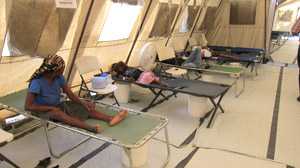Sources of Infection & Risk Factors

People laying down on cots in a makeshift treatment facility in Haiti.
Cholera is an acute intestinal infection causing profuse watery diarrhea, vomiting, circulatory collapse and shock. Many infections are associated with milder diarrhea or have no symptoms at all. If left untreated, 25-50% of severe cholera cases can be fatal.
Frequently Asked Questions
Who gets cholera?
A person can get cholera by drinking water or eating food contaminated with the cholera bacterium. Large epidemics are often related to fecal contamination of water supplies or street vended foods. The disease is occasionally spread through eating raw or undercooked shellfish that are naturally contaminated.
Who is more likely to be exposed to cholera (toxigenic Vibrio cholerae O1)?
People who are more likely to be exposed to cholera include healthcare personnel treating cholera patients, cholera response workers, and travelers in an area of active cholera transmission who cannot or do not always follow safe food and water precautions and personal hygiene measures.
Who is more likely to have poor outcomes from cholera?
Individuals with achlorhydria (the absence of hydrochloric acid in digestive stomach juices), blood type O, chronic medical conditions, and those without ready access to rehydration therapy and medical services are more likely to have poor outcomes, or get sicker, from cholera.
Environmental Source
Brackish and marine waters are a natural environment for the etiologic agents of cholera, Vibrio cholerae serogroup O1 or O139. There are no known animal hosts for Vibrio cholerae, however, the bacteria attach themselves easily to the chitin-containing shells of crabs, shrimps, and other shellfish, which can be a source for human infections when eaten raw or undercooked.
About Vibrio cholerae O1 or O139
Cholera is caused by infection with toxigenic Vibrio cholerae serogroups O1 or O139.
- Only toxigenic strains of serogroups O1 and O139 have caused widespread epidemics and are reportable to the World Health Organization (WHO) as "cholera".
- V. cholerae O1 has two biotypes, Classical and El Tor, and each biotype has two distinct serotypes, Inaba and Ogawa. The symptoms of infection are indistinguishable, although a higher proportion of persons infected with the El Tor biotype remains asymptomatic or have only a mild illness.
- In recent years, infections with the Classical biotype of Vibrio cholerae O1 have become quite rare and are limited to parts of Bangladesh and India.
Many other serogroups of Vibrio cholerae, with or without the cholera toxin gene, can cause a cholera-like illness, as can non-toxigenic strains of the O1 and O139 serogroups.
Cholera in the U.S.
In the U.S., the occurrence of cholera is very low (0-5 cases per year) and is usually due to ingestion of contaminated food or international travel. There has been a modest increase in imported cases since 1991 related to travel and ongoing epidemics.
Global Cholera Epidemics
Cholera is a major cause of epidemic diarrhea throughout the developing world. There has been an ongoing global pandemic in Asia, Africa and Latin America for the last four decades. In 2011, a total of 58 countries reported a cumulative total of 589,854 cases including 7,816 deaths (case fatality rate of 1.3%) to the World Health Organization (WHO). There was an 85% increase in number of cholera cases as a result of the Haiti cholera outbreak in October 2010. Resource-poor areas continue to report the vast majority of cases with the African continent having the worst case fatality rates 1.
Global Cholera Challenges
Large population migrations into urban centers in developing countries are straining existing water and sanitation infrastructure and increasing disease risk. Epidemics are a marker for poverty and lack of basic sanitation. Multiple routes exist for spreading cholera meaning that successful prevention may require different measures in different areas.
Natural infection and currently available vaccines offer incomplete protection of relatively short duration; no multivalent vaccines are available for O139 infections.
Simple rehydration treatment saves lives, but logistics of delivery in remote areas remains difficult during epidemic periods. Accompanying antibiotic treatment is helpful but may be difficult because of growing antimicrobial resistance. Natural reservoirs for the bacterium in warm coastal waters make eradication very unlikely.
Reference
- WHO. Cholera 2011. [PDF - 16 pages] Wkly Epidemiol Rec. 2012;87: 289–304.
- Page last reviewed: November 9, 2016
- Page last updated: November 9, 2016
- Content source:


 ShareCompartir
ShareCompartir